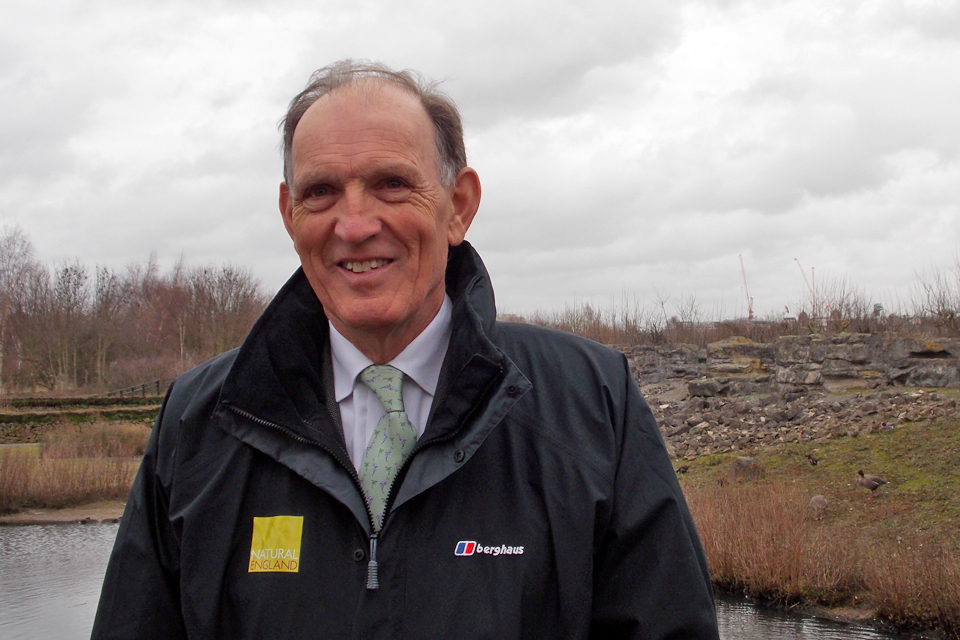Nature Improvement Areas partnerships
Speech by Andrew Sells, Chairman of Natural England, to the Nature Improvement Areas Annual Forum.

Thank Sir John and the Minister.
I’d like to echo your comments and take this opportunity to thank the 12 Nature Improvement Areas (NIA) on behalf of Natural England for the enormous contribution you’ve made, and continue to make, to conservation across England.
The statistics speak for themselves – the partnerships that you’ve built have shaped half a million hectares, created, enhanced and restored nearly 24,000 hectares of habitat and over 250 km of hedgerows, rivers and riverbank. This is a remarkable achievement, which set us on the road to reaching the aspirations set out in Biodiversity 2020.
This is an achievement that will leave a lasting legacy – wildlife will return, people will be able to enjoy all the benefits that nature brings.
Nature Improvement Areas have also brought Sir John Lawton’s vision to life. This is also an important part of your legacy – you’ve acted as a test bed for a new and innovative approach to conservation.
An approach which recognises that conservation initiatives are at their most successful when they are locally designed and locally managed. When partners and local people come together to restore their landscape and shape their natural environment.
The NIA partnerships you’ve mobilised and marshalled continue to make a real impact locally. They’ve brought energy and focus to conservation, sharing ideas, improving collaboration and getting more done for less.
You’ve followed this locally-led approach and made it a success. There are important lessons here and I can assure you that Natural England is listening and learning.
We’ve recently moved to a local delivery model, with the creation of 14 Area Teams who’ve been mandated to work more closely and more collaboratively with local partners, and are empowered to make decisions that best fit local circumstances.
Our local model is there to enable this sort of local initiative, which I very much hope we’ll see more of in the future.
Because conservation needs innovation – we need strong local partnerships to develop and agree solutions that meet their needs and aspirations. We need to find new ways of managing the land, and new ways of securing and capitalising on the goods and services the natural world provides.
In the Dark Peak for example, you’ve improved and created blanket bog and native woodland to store carbon; in other places like the Culm (in North Devon) and the Dearne Valley (in South Yorkshire) flood plain restoration is helping to manage water and reduce flood risk.
In other places you’ve developed new nature tourism initiatives, and in so doing found ways to bring new money into the conservation sector.
As well as the significant differences you’ve made on the ground, and the important partnerships you’ve built, you’ve collectively generated a huge body of knowledge and practical understanding. There’s new research on a wide range of topics, waterways and pollution, on rare habitats like grassland and on rare species of orchids and butterflies, and freshwater species like pearl mussels.
Your research has investigated how to make woodland management pay, and set out the health and other benefits of greener towns and cities.
This body of knowledge, as well as your experience and expertise, will help shape conservation interventions in years to come.
The government deserves huge credit for finding and protecting the millions of pounds it put into the NIA programme, and so thank you Lord de Mauley on behalf of us all.
And you (NIAs) deserve huge credit for entrepreneurial spirit you’ve demonstrated in using this money.
You’ve proved adept at bringing additional funding streams – from public bodies and private trusts, from landfill credit tax and the national lottery, and private donations.
£3.50 for every £1 of grant funding is a pretty sound return on investment – it’s certainly one I’d be happy with in my previous life as an investor.
I’m delighted to hear that a number of NIAs have secured funding to continue to 2020, and I hope that others will secure funding over the remainder of this year. Our local teams will help you here where they can.
As the minister has mentioned, we are hopeful that the New Environmental Land Management scheme will have a role to play in the future, supporting this type of partner-led landscape scale conservation initiative.
Before I close, I wanted to say a final word about the people power you’ve unleashed. There is a considerable conservation challenge to meet, one which requires a huge mobilisation of people and resources.
You’ve demonstrated that it is possible to mobilise huge numbers of local people. There were over 5,000 volunteering days given up in year 1, and more than 16,000 in year 2.
Volunteers have planted hedges and trees, cleared scrub and transplanted plants.
You’ve created new social networks and reinvigorated old ones – and social networks that are delivering change on the ground rather than sharing holiday snaps on Facebook.
NIAs have brought communities and partnerships together – land owners and farmers; schools and community group. All sharing knowledge, gaining expertise and working together for the good of the natural environment.
In recent years there’s been much written about new models of conservation, most eloquently by Sir John Lawton.
You’ve begun to bring this vision to life. And for that you deserve sincere thanks and many congratulations.